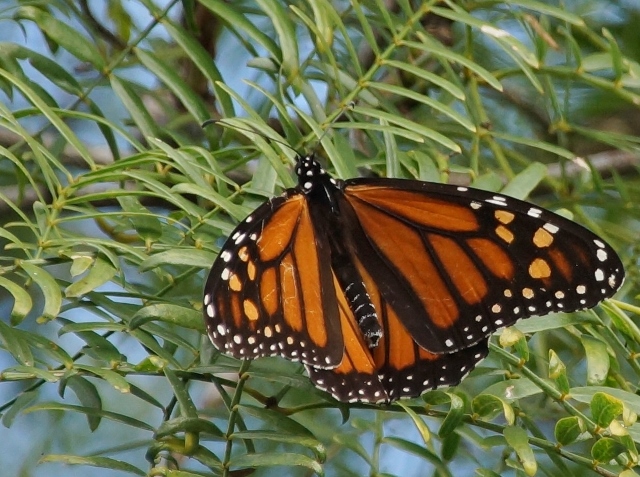by Paula Parson

(Photo by Paula Parson.)
During my youth in Hawaii, monarch butterflies were present year-round spending their entire life-cycle on the crown flower plant, a giant milkweed. Imagine my surprise when I learned that on the mainland, monarchs migrate thousands of miles in the fall, flying south to the mountains of Mexico, then returning north in the spring.
There has been a marked decline in the number of butterflies making this trek. Several factors contribute to this decline: loss of habitat in North America due to agriculture and development, cutting of oyamel fir forests in Mexico, and severe weather at overwintering sites.
Recently, genetically modified crops and widespread application of consumer weed killer, decrease of Conservation Reserve Program lands, insecticide use by commercial plant growers and climate change have contributed to the issue. Spraying to control mosquitoes may also contribute to the problem locally.
Monarch butterflies fly 50 miles daily, stopping to replenish their nectar after about 48 hours. Many organizations in Texas are working to establish a chain of native nectar and host plant areas to help these butterflies make a successful flight south.
There are 62 species of milkweed statewide. The most common genus of milkweed is Asclepias, with 37 recognized species, 36 of which are Texas natives.
The exception is the Tropical Milkweed, popular in many butterfly gardens. This plant is both a nectar and host plant, and contains a chemical that may encourage monarchs to remain in the area laying eggs that may not survive to adulthood. One school of thought recommends that this milkweed be cut to six inches monthly from October to February and to pinch off the leaves so monarchs cannot use it as a larval plant to lay eggs during those months.
Fall-blooming wildflowers that can be planted now, like cowpen daisy, blazing star, frostweed and Maximilian sunflower will provide nectar for monarchs as they move south to their winter grounds. In the spring as they migrate north, monarchs need milkweeds for egg-laying and rearing their young, which the Tropical Milkweed can then provide.
Providing varied nectar and host plants for the monarch will also benefit other butterflies, moths and many other valuable pollinators.
